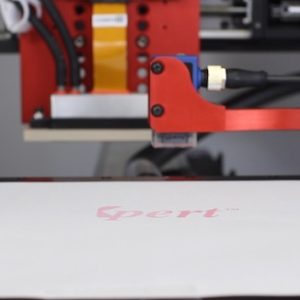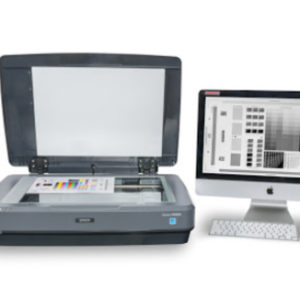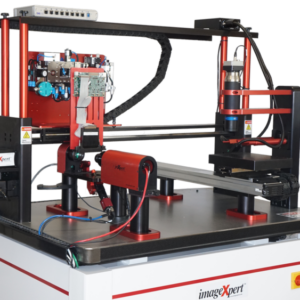What Ink is Right for My Application?
Last Updated on June 25, 2024 by ImageXpert Team
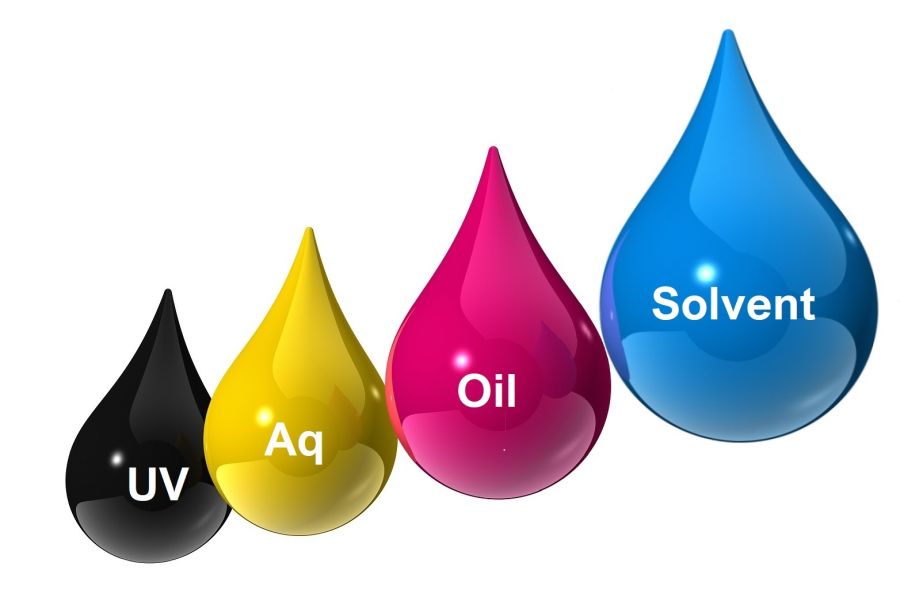
Do you want to develop a process using digital inkjet printing but are unsure what type of ink chemistry is right for you? Bewildered by the number of options available and not clear on the differences between them? In this post we’ll lay the groundwork for your decision making process by outlining what ink options are available for the most common inkjet applications and the pros and cons of each.
For this first discussion, we will limit ourselves a little to keep things simple by assuming that you want to print an image of some description. In future posts, we will discuss inks for special applications, like 3D printing or electronics.
The mainstream ink chemistries are classified primarily by diluting material, which provides the viscosity control, and secondarily by the function. The most common diluting materials are UV, aqueous or water-based, oil, and solvent. All the main families described above have been used in traditional printing methods for a differing number of years, and often some of the reasoning for their use will be inherited into inkjet.
The dominant factor in deciding which of these four ink chemistries to use has always been related to the surface that needs printing. The surface will determine if wetting occurs, how much of the fluid is absorbed, chemical interaction, and how the ink dries. Keep in mind that the final decision on which ink is best for a particular application is subject to many other factors, but determining what type of surface you will be printing on is a good starting point. We’ve broken down the potential surfaces to be printed into five general categories below.
POROUS SURFACES
Inkjet printing research is a constant progression towards finding inks that dry really well onto the surface but not in the printhead. For some surfaces, the only way to print on them is to use inks that dry very quickly and solidly, making using them in a printhead a very high maintenance proposition. Porous surfaces, such as paper or corrugated, do not have this problem, as ink absorbs readily into them. Instead, printhead reliability is the highest priority and challenge due to the expected intermittent use. Non-industrial customers are not running the printers all the time, and even after weeks of sitting idle, the first print is expected to be good. For this reason, low-maintenance, reliable inks are desired.
Water-based inks are the most common choice for porous surface applications because they can accomplish this at the lowest cost. Aqueous inks can be formulated with plenty of humectants (water-loving materials) so that the water is not lost so easily from the nozzle during inactivity, making them more reliable. The cost to produce is low because the inks can be formulated and manufactured with dyes and work in both PIJ and TIJ printheads.
Although aqueous ink tends to be reliable, another even more reliable alternative exists. For many years RISO has made a printer for the small office market using oil-based inks for precisely the same reason of easy drying balanced with head reliability. DOD coding systems for corrugated cartons also take advantage of oil-based inks. Most oil-based inks have low volatility and thus are more stable in print heads but it also means they can be removed only at elevated temperatures.

Although more reliable, the migration of residual materials in oil-based inks can be undesirable. For example, in 2011, mineral oils arising from offset inks used in recycled newspaper were found in cereals. This resulted in a ban of the use of recycled pulp into such sensitive applications & drove direct-to-board coding towards mineral oil-free inks. Although water-based inks don’t generally have the same toxicity as mineral oils, chemical migration compliance cannot be assumed.
It is important to keep in mind that absorption is not always your friend. It can result in colour loss, which occurs when the colorant is drawn into the substrate. Different ink colours can also interact when printed next to each. This is known as ink bleed. Both water-based and oil-based inks that rely too much on surface absorption as the primary drying method may suffer from this problem.
Conclusion: For low-cost, more environmentally and human-friendly inks, start with aqueous. For higher reliability, explore oil-based inks.
NON-POROUS AND/OR POLYMERIC MEDIA
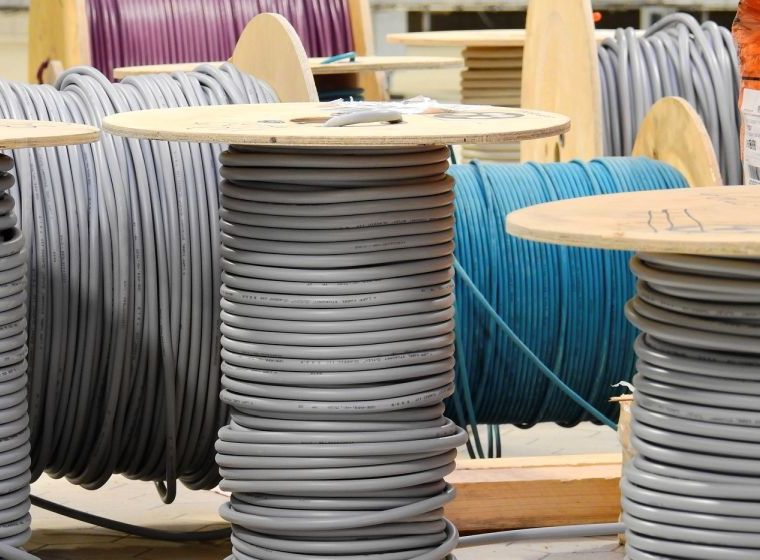
This category is practically a catch-all for everything else that’s not paper, other than textiles or un-fired tile, which are both quite special cases. Fast drying is important to avoid bleed, so now head reliability must be balanced in order to formulate inks that will dry to the substrate. UV inks have dominated the industrial printing of non-porous media since they can be cured immediately, yet stable in the print head and can be formulated for a variety of requirements. By choosing the mixture of monomer and resins, the skilled formulator can produce the utmost flexibility (e.g. thermoforming, vehicle wraps) or solvent resistance (e.g. glass printing, ). Of the different applications, wide-format printing has seen the greatest growth in UV in the 21st century but over the last 10 years volume has grown steadily into labels and décor on the back of single-pass printer developments.
Solvent inks have also been a mainstay in non-porous surface applications, mostly for wide format graphics and coding. They offer higher levels of flexibility and gloss, which is desirable for some wide format graphic applications. Additionally, in traditional print methods, like pad printing, the substrate adaptability and resistance property delivered by solvent is hard to beat. Getting that resistance into an inkjet ink is a little more difficult but nevertheless, solvent inks are still the go-to for durable coding and marking of surfaces, both CIJ and DoD.
Some of the challenges with working with solvent inks are related to safety and reliability. In graphics, formulators generally rely on special polymeric media to optimise the print quality, especially as slower drying inks have been adopted to address workplace safety concerns. Also, “harder” solvents are known for having latency challenges.
Aqueous inks with a functional component have been promoted by HP from 2008 and others since (e,g, Sepiax). The fundamental motivation is the improved environmental profile, which positioned the so-called “latex” inks originally against solvent inks. Since 2012 the launch of HP’s wider 3000 series printers, however, Latex has been competing more and more with UV.
The principle of this type of ink is to thermally cure the “latex” polymer after printing. The invention was not new to HP, but previous attempts lacked HPs inertia for driving market success. The first versions disclosed needed high temperatures (e.g. Lexmark, US6498202, 1999) but this is now being steadily lowered. It should not be too low though, otherwise the polymer can become too difficult to maintain in the print head.
Like solvent inks, the print process target is to balance the drying property in the print head versus the print quality on a non-absorbing substrate, which will inevitably lead to colour bleed. In a technical note on their website, HP highlight the danger of using aftermarket latex inks because of the poor ink bleed and nozzle reliability performance.
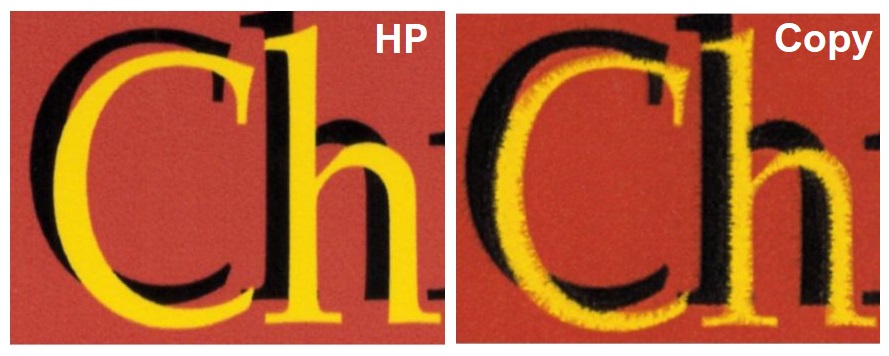
The end-use challenge with such aqueous inks is to get the same resistance that end users have gotten used to obtaining with solvent or UV. This is part of the reasoning for hybrid Aq-UV inks, which replace the thermal curing step with UV. This has the potential to improve end-use performance with less of an adverse effect on head lifetime.
Conclusion: For best all-around ink, choose UV inks. For best durability/resistance, choose solvent inks. For better environmental / human safety, explore latex/aqueous inks.
Join Our Mailing List
TEXTILES
Textile printing is a bit of a special case because the materials to be printed can be simultaneously porous (due to the weave) but also non-absorbing (at the fibre level).
The ink chemistries are varied due to the different requirements of each fabric (see table below), but the dominant carrier technology in the market is water-based. The majority of inkjet volume is in disperse dyes for direct-to-garment or sublimation printing although some of the first inks used in small wide-format machines were acid and reactive dyes. Pigmented inks for textiles is still an up-and-coming application in terms of volume and is dominated by the well-proven Dupont Artistri® ink.

UV ink and latex inks have been applied successfully to textile-style substrates but mostly for the application of soft signage. The feel of the printed layer is an important consideration for clothing and the high solid content of conventional UV restricts it application. Latex is promoted as suitable by HP and the lower solids of less than 20% (from US9187667).
Conclusion: Most applications point to aqueous inks. If the feel of the textile is not a primary concern, explore graphics UV or latex inks.
CERAMIC, GLASS & WOOD

When inkjet is applied to decorative surfaces, it is often a little more complicated than what we’ve looked at so far. The ink is usually a layer within a stack of materials that are applied as part of a manufacturing process. Ceramic tile printing is a great example of this which we will explore in detail another time. The inks are printed onto pressed powders, the “green” tiles, that are pre-coated with glazes and post-treated with enamels. Due to the firing process the coloration comes from inorganic pigments that are fired and develop their gamut when they react with the glass.
A similar pigmented approach can be used on glass to provide architectural quality printing as exemplified by the image above, performed using technology from Dip Tech. Although the printer looks little more like a standard graphics printer, the process is very specific and involves a lot of heating to ensure fast enough drying on the completely non-absorbing glass, a bit like the larger HP latex printers.
In other areas of decor, rolls of paper and sheets of composite boards are high pressure laminated with melamine using organic pigments for the colour. Inks are conventionally aqueous but special UV products have been developed too.
Where simple surface print is desired, then the general rules above for absorbing and non-absorbing media can be followed. Untreated wood is quite absorbing whilst treated or coated wood or engineered materials like MDF are less so. Stone or concrete are capable of some absorption too. In these cases the ink should be chosen for the fade resistance property based on the likely environmental exposure and expected life of use. Inorganics ceramic inks have been used to address this but over-coating organic pigments in UV inks can close the gap.
Conclusion: Graphics UV and aqueous inks are often used for surface print applications and clear over-varnishes can extend the lightfastness. In specific applications, highly targeted inks can be more successful for better end-use performance.
ELECTRONICS AND 3D PRINTING
The fluids used in these industries are very specific and so are likely to have been developed from scratch for certain properties. The possibilities are far too numerous to try and mention in this post. Please do contact us and we will do what we can to point you in the right direction.
SUMMARY
Now that you’ve been pointed in a general direction of which ink to choose based on the surface you are printing on, it is time to explore some of the other considerations that go into choosing an ink. Not only is the ability to print on a material important, the end-use properties are also a critical factor. The flexibility, resistance property, migration of raw materials (e.g. to food), and more all must be considered. This is unique to your specific application and must be considered carefully.
The best way to compare the chemistry and usage of many different types of inks is in a table. The table below is adapted from Table 3.1 in Handbook of Industrial Inkjet Printing: A Full System Approach, edited by Werner Zapka (Wiley, 2017); a very useful book that takes the discussion much further.
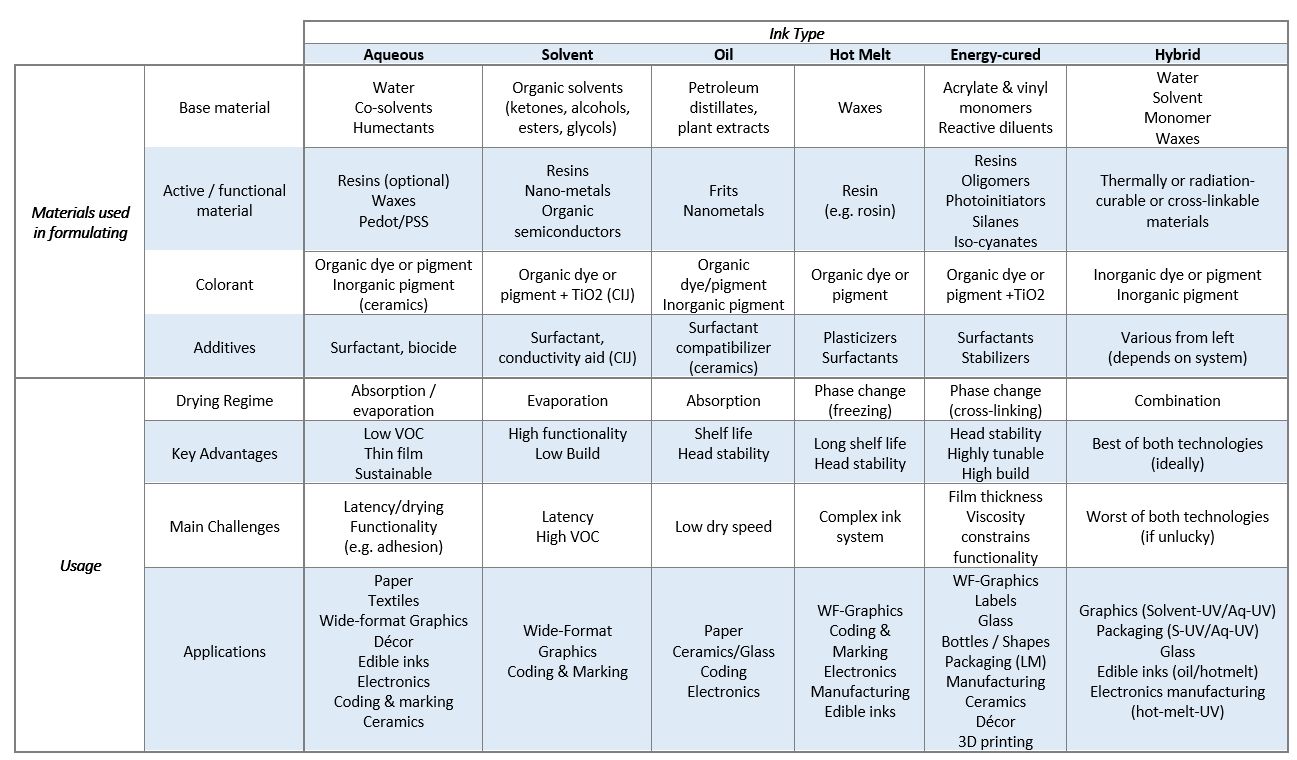
We’ll come back to discuss some details later, but in the meanwhile let us know if you have comments or questions. We would really appreciate suggestions on future topics too.

